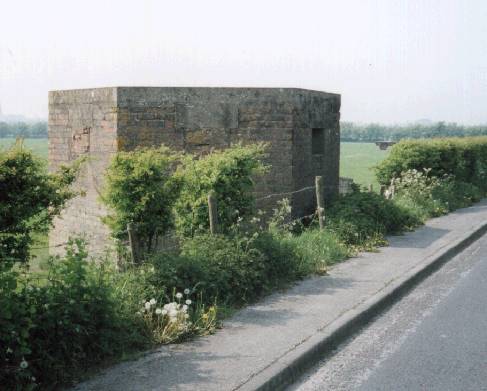 One of North Cumbria's
better-known wartime sites, Silloth aerodrome owed its existence to the Royal Air Force
Expansion Scheme, and was opened in June 1939 to meet the demand
of storing newly-manufactured aircraft.
One of North Cumbria's
better-known wartime sites, Silloth aerodrome owed its existence to the Royal Air Force
Expansion Scheme, and was opened in June 1939 to meet the demand
of storing newly-manufactured aircraft. One of North Cumbria's
better-known wartime sites, Silloth aerodrome owed its existence to the Royal Air Force
Expansion Scheme, and was opened in June 1939 to meet the demand
of storing newly-manufactured aircraft.
One of North Cumbria's
better-known wartime sites, Silloth aerodrome owed its existence to the Royal Air Force
Expansion Scheme, and was opened in June 1939 to meet the demand
of storing newly-manufactured aircraft.
It was built as a Maintenance Command station, but was transferred to Coastal Command with the 22 Maintenance Unit forming a station within. The Coastal Command group pool had been re-designated No:1 Operational training Unit in April 1940, being replaced by No:6 O.T.U in March 1943.
It was at Silloth that one of the predecessors of the modern flight simulator was developed; - the "Silloth Trainer". This was a Hudson fuselage fitted up with electrics and pneumatics to simulate engine sound, instrument readings, and movement.
Presumably the trainer was based on the Lockeed Hudson, as so many were used at Silloth, arriving there - brand new - from the USA and Canada. Many of these aircraft remain in the Solway Firth, hence it being known locally as 'Hudson Bay'. Hudsons played a major role at Silloth, and there remains much to be learned; many mysteries to be solved.
After WWII ended, No:22 Maintenance Unit took over the aerodrome, which was used largely for scrapping and storage. The late Bill Elliot (G4BIU) was a Wireless Op. at Silloth during WWII, and told of hordes of Lancaster bombers, minus their outer engines and wing-sections waiting to be transferred to High-Duty Alloys at Distington for aluminium recovery at the end of the war. I have heard anecdotes from various sources hinting at a large hole "somewhere near Silloth" being filled in with surplus radio equipment, bombsights, instruments, and other goodies no longer needed. (I have also heard tales of large holes at other aerodromes; probably common practise and may have been part of the "Lend-Lease" agreement which resulted in spanking new aircraft being hauled off a carrier into deep sea, following the cessation of hostilities).
Silloth aerodrome hung on until 1960, having experimented with civil scheduled flights to the Isle of Man in 1956. I remember visiting the aerodrome in 1978 to see an air-show, and a Hawker Sea-Fury had actually landed and taken off the runway there. I don't know if anything has landed there since. The aerodrome is better remembered by a younger generation as the one-time stadium of the "Helldrivers", a destruction-derby sort of thing. It will no doubt be remembered also by the many fifteen and sixteen-year-olds who first took to the wheel of a car on the runways. It is now the site of a thriving industrial area and Sunday market.
The few pieces of defence infrastructure on these pages are just that; the aerodrome hosts numerous buildings, many in relatively good condition which remain to be recorded. This was addressed - partially - in September 2001, when I was fortunate enough to be invited on a trip around the aerodrome. The photographs can be found on the Silloth (II) page.
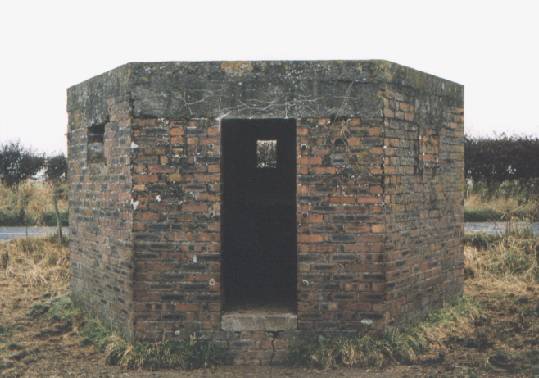
This brick-built type 22 pill-box stands guard just up the road from the aerodrome's main entrance. The embrasures face the aerodrome and look up and down the road, with the door at the opposite side. For some reason, some of the embrasures have been bricked up. It is of a similar pattern to the one at Kirkbride aerodrome.
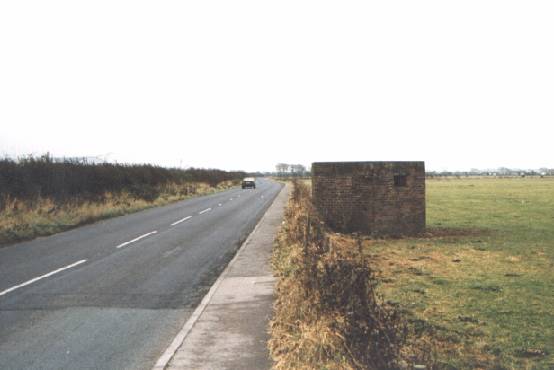
The view towards Abbeytown. This pill-box is passed by hundreds of motorists on the B5302 each day, perhaps without a second glance. Construction appears to be brick throughout, rather than just used for shuttering.
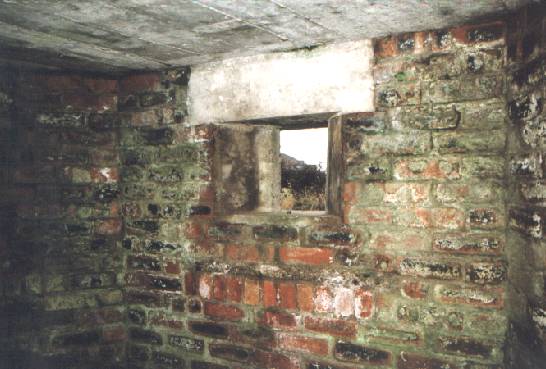
View of the embrasure from inside with a steel frame around it. A rifle or light machine-gun would have been used here.
The unusual - and awesome - pill-box shown is to be found at the NE side of the airfield. It is a type F/W22 with "wings" attached. Open-ended, and loop-holed front and rear, this must have been some defence!

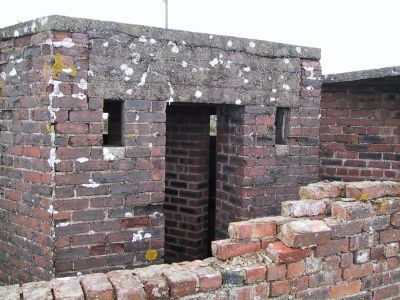 |
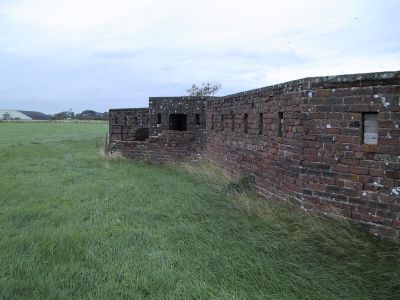 |
| ABOVE: The pill-box from the rear, showing the anti-ricochet pillar - delta, or "Y" - shaped in section. BELOW: Inside the actual pill-box. The wooden shelves below the loopholes are still intact, and have not been salvaged for firewood, as is the case with many other pill-boxes. A metal frame is evident in the loophole to the left of the photo. |
ABOVE: A rear-view of the "wing". Slightly larger loopholes than the pill-box, and a 30-ish° kink in horizontal alignment. Both extensions similar. Why so? Note the blister-hangar in the background, one of several still extant in the area. BELOW: Inside view of the "wing". |
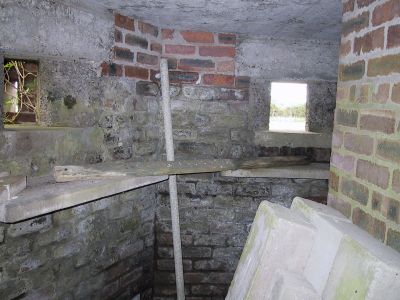
|
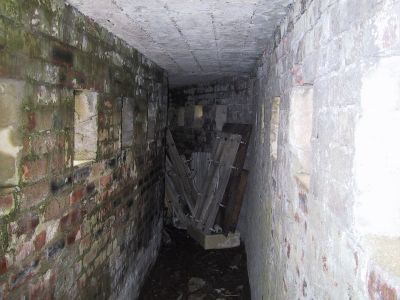
|
"Stanton" pre-fabricated air-raid shelter.
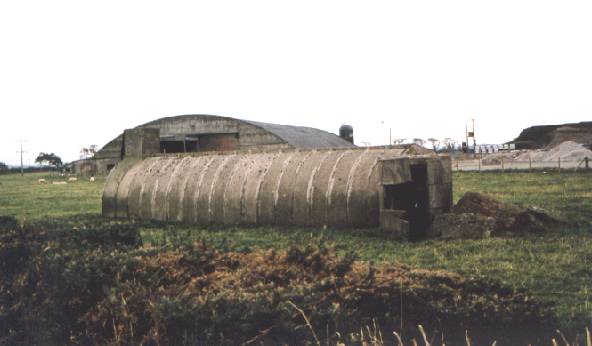
The "Stanton" air-raid shelter was of prefabricated design, and consisted of sections which could be bolted together to form different lengths. The main entrance is to the right, and the chimney-type structure to the left is the emergency exit. The shelter is devoid of the earth banking which would normally cover it. Blister-hangar present in the background.
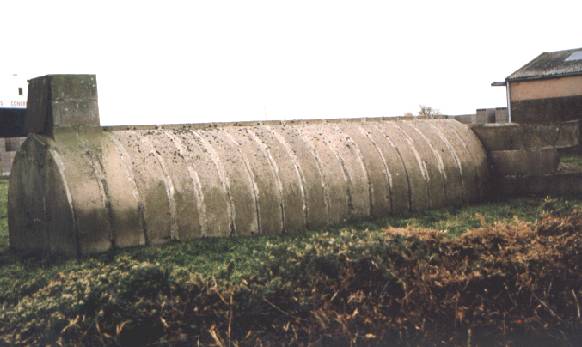
The sectional construction and the escape-hatch can be seen more clearly in the above picture. The shelter is surrounded these days by light industry, agriculture, and storage; all of which make good use of the remaining buildings.
A "D"-type hangar near the entrance to the Sunday market. It is in good repair and is part of a nearby factory.
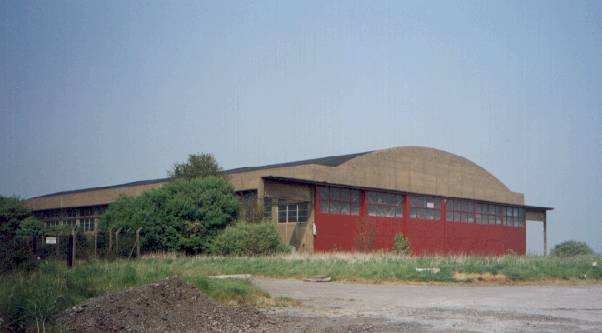
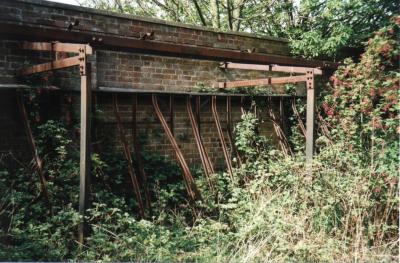 Ever seen those old war films about the RAF, where everyone is scurrying furiously around the
airfield on bicycles?. Here's where they kept them (at Silloth, anyway). The bike rack, behind
the main guard-house. Rusty and overgrown, but still there....
Ever seen those old war films about the RAF, where everyone is scurrying furiously around the
airfield on bicycles?. Here's where they kept them (at Silloth, anyway). The bike rack, behind
the main guard-house. Rusty and overgrown, but still there....
This picture was taken by Jeff Wilson, who also provided the one of the guardhouse below. The chap in the centre of the photo was Jeff's "guide". Despite the new roof and secure doors and windows, it still retains its pleasing brickwork utilitarian look, and is probably now part of the nearby industrial complex
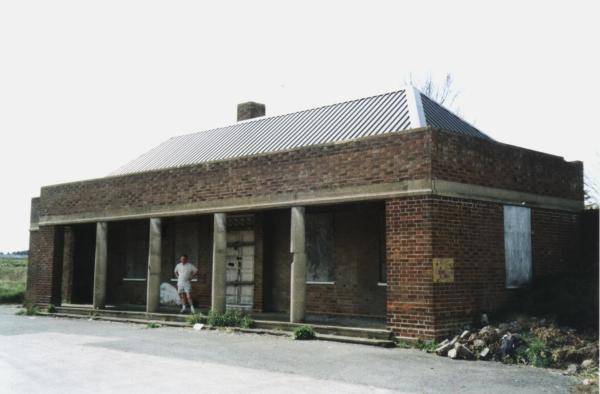
Home | Contents | Workington | Links | E-Mail